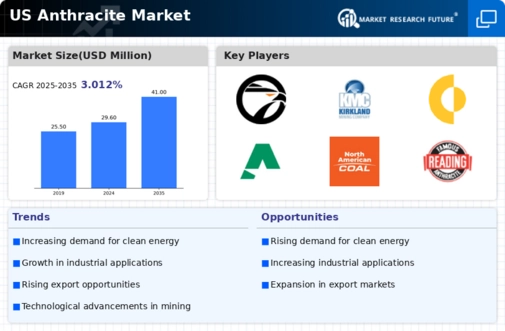The US Anthracite Market is experiencing a dynamic landscape characterized by increasing demand driven by industrial applications and energy production. As a cleaner alternative to other fossil fuels, anthracite coal is gaining traction, particularly in the metallurgical and heating sectors. The competitive environment is marked by various players who are focusing on technological advancements, ecological sustainability, and supply chain efficiency to gain an edge. Companies operating within this market are leveraging digital transformation and strategic partnerships to enhance their operational capabilities and market reach.
The interplay of regulatory pressures and evolving consumer preferences towards greener energy sources further amplifies the need for companies to innovate constantly and adapt their strategies to differentiate themselves in this competitive arena. Luzerne Anthracite has carved a reputable position within the US Anthracite Market, mainly characterized by its strong emphasis on quality and reliability. The company is recognized for maintaining high standards in the mining and processing of anthracite coal, which has earned it a loyal customer base in various industrial sectors.
With a focus on producing premium-grade anthracite, Luzerne Anthracite capitalizes on its strategic positioning in Pennsylvania, a region known for rich anthracite reserves. The company's strengths lie in its advanced mining techniques and commitment to sustainable practices, which not only drive operational efficiency but also align with the growing trend towards environmental responsibility. By fostering long-term relationships with customers and investing in continuous improvement, Luzerne Anthracite remains a prominent player in this evolving market space.
Pike Coal stands out as a competitive entity within the US Anthracite Market, primarily through its diverse portfolio that includes various types of anthracite products for different applications, including industrial processes and residential heating solutions. The company has established a strong market presence and reputation for excellence, leveraging its extensive distribution network throughout the northeastern United States. Pike Coal focuses on innovation that enhances product quality and minimizes environmental impact, thereby appealing to both traditional markets and eco-conscious consumers.
Strengthened by its strategic mergers and acquisitions, Pike Coal has expanded its capabilities and resources, allowing it to streamline operations and improve service delivery to its clients. The company’s commitment to customer satisfaction and its proactive approach to market challenges further solidify its foundation as a key player in the US anthracite landscape.



















Leave a Comment